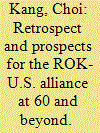| Srl | Item |
| 1 |
ID:
125264


|
|
|
|
|
| Publication |
2013.
|
| Summary/Abstract |
The year 2013 marks the 60th anniversary of the ROK-U.S. alliance. The catchphrase "We go together," which is used in the ROK/U.S. Combined Forces Command (CFC), well captures its founding spirit. Since the beginning of the alliance, with the signing of the ROK-U.S. Mutual Defense Treaty in 1953, it has been a key element in both countries' security strategies. Both have agreed to upgrade the alliance to "strategic alliance." To realize a strategic alliance, clear guidelines that go beyond simple rhetoric must be adopted and an action plan devised through intense discussions. For that purpose, it is essential for South Korea and the United States to undergo a bottom-up review process of the alliance. It is important to pay careful attention to: identification of challenges the two must cope with together (for what); the division of labor (who should do what); plans and strategy (how); and cooperation mechanisms (through what). Along these lines, it is important to think about how to enrich the contents of military cooperation as the backbone of the alliance. To avoid any misunderstanding and over-expectations of the United States, South Korea must make it clear what it can and cannot do on the basis of undiminished mutual respect.
|
|
|
|
|
|
|
|
|
|
|
|
|
|
|
|
| 2 |
ID:
156474


|
|
|
|
|
| Summary/Abstract |
For Korean Peninsula watchers, the two most recent years have been tainted by
further North Korean provocations. Three nuclear tests and a series of missile tests
are signs that the North Korean nuclear crisis has reached a different level. While
talks have focused on deterring the use of nuclear weapons or destroying incoming
missiles using missile defense systems, relatively not much has been discussed
about North Korea’s nuclear strategy and doctrine. To make extended deterrence
against North Korea truly effective and fine-tune our counter–provocation strategy,
we need to think about how North Korea would use its nuclear weapons before
or during a war. One way to gain insight into its strategy is to examine its nuclear
doctrine. Whatever the initial purpose the North Korean leadership had in mind, it
has become clear that it is trying to build a second–strike capability, but whether
its nuclear doctrine is based on an “assured retaliation” or “asymmetric escalation”
strategy is to be watched carefully. North Korea’s reality indicates that an assured
retaliation strategy is more likely. But as its nuclear capability develops, it could aim
to adopt an asymmetric escalation strategy in the long-term. Before they accomplish
that goal, the ROK–U.S. alliance should find an effective means of changing North
Korea’s strategic thinking.
|
|
|
|
|
|
|
|
|
|
|
|
|
|
|
|